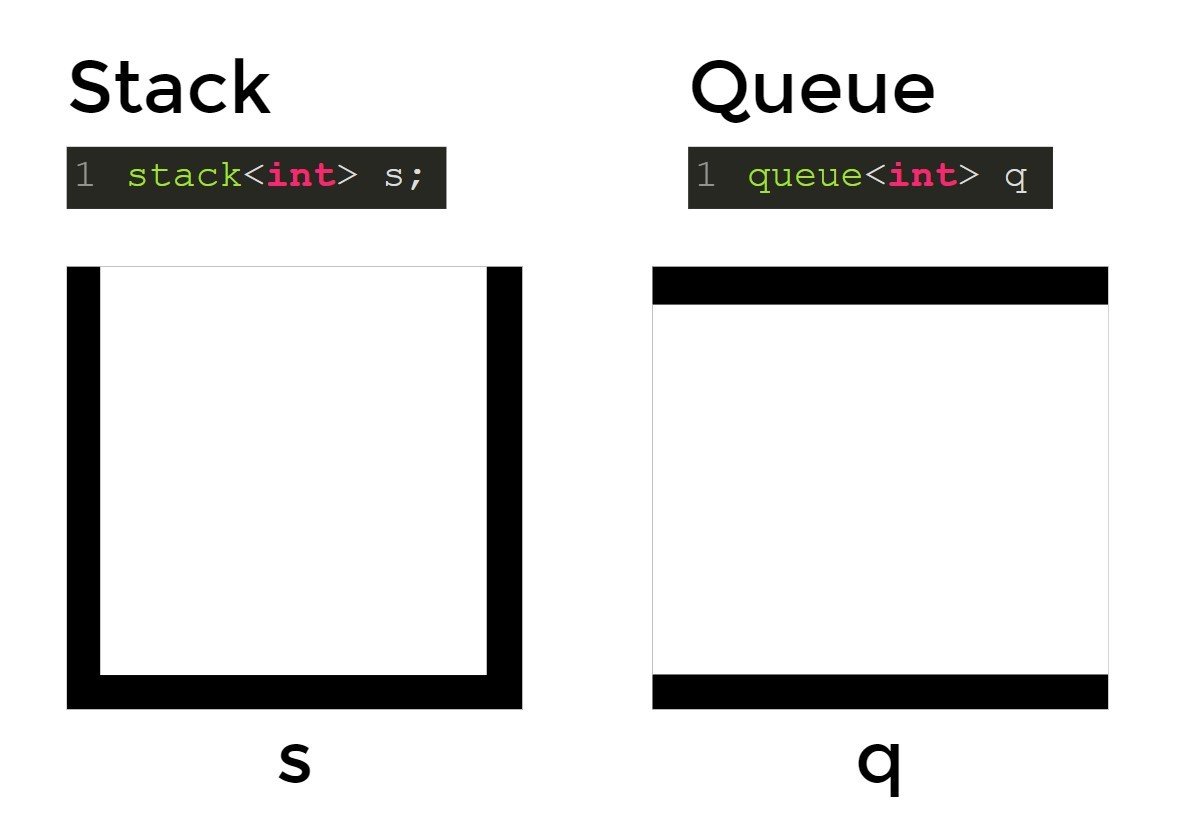Stack
&Queue
Stack
&Queue
介紹
Stack(堆疊)
Stack
- 需引入函式庫<stack>
- 為連續記憶體空間
- 先進來的後出去(lifo)
Queue(佇列)
Queue
- 需引入函式庫<queue>
- 為連續記憶體空間
- 先進來的先出去(fifo)
Stack
Queue
stack<int> s;queue<int> q;s
q
stack/queue<型態>名稱;
| Stack | 功能 |
|---|---|
| push(x) | 放入元素 |
| pop() | 刪除第一個元素 |
| top() | 讀取最上面的元素 |
| empty() | 是否為空 |
| size() | 內有幾個元素 |
| Queue | 功能 |
|---|---|
| push(x) | 放入元素 |
| pop() | 刪除第一個元素 |
| front() | 讀取最前面的元素 |
| empty() | 是否為空 |
| size() | 內有幾個元素 |

是 否 為 空 ?
s.empty()
q.empty()

內含幾個元素 ?
s.size()
q.size()
Stack
lifo
(last-in-
first-out)
Stack
s
lifo
(last-in-
first-out)
Stack
lifo
(last-in-
first-out)
Stack
s
lifo
(last-in-
first-out)
1
s.push(1)
Stack
lifo
(last-in-
first-out)
Stack
s
lifo
(last-in-
first-out)
1
s.push(1)
Stack
lifo
(last-in-
first-out)
Stack
s
lifo
(last-in-
first-out)
1
s.push(2)
2
Stack
lifo
(last-in-
first-out)
Stack
s
lifo
(last-in-
first-out)
1
s.push(2)
2
Stack
lifo
(last-in-
first-out)
Stack
s
lifo
(last-in-
first-out)
1
s.push(3)
2
2
3
Stack
lifo
(last-in-
first-out)
Stack
s
lifo
(last-in-
first-out)
1
s.push(3)
2
2
3
s.top()
Stack
lifo
(last-in-
first-out)
Stack
s
lifo
(last-in-
first-out)
1
s.push(3)
2
2
3
s.top()
s.pop()
Stack
lifo
(last-in-
first-out)
Stack
s
lifo
(last-in-
first-out)
1
s.push(3)
2
2
3
s.top()
s.pop()
Stack
lifo
(last-in-
first-out)
Stack
s
lifo
(last-in-
first-out)
1
s.push(3)
2
2
3
s.pop()
Stack
lifo
(last-in-
first-out)
Stack
s
lifo
(last-in-
first-out)
1
s.push(3)
2
2
s.pop()
Queue
q
fifo(first-in-first-out)
q.push(3)
Queue
q
fifo(first-in-first-out)
q.push(1)
1
Queue
q
fifo(first-in-first-out)
q.push(1)
1
Queue
q
fifo(first-in-first-out)
q.push(2)
1
2
Queue
q
fifo(first-in-first-out)
q.push(2)
1
2
Queue
q
fifo(first-in-first-out)
q.push(3)
1
2
3
Queue
q
fifo(first-in-first-out)
q.push(3)
1
2
3
q.pop()
q.front()
Queue
q
fifo(first-in-first-out)
q.push(3)
1
2
3
q.pop()
q.front()
Queue
q
fifo(first-in-first-out)
q.push(3)
1
2
3
q.pop()
Queue
q
fifo(first-in-first-out)
q.push(3)
1
2
3
q.pop()
Queue
q
fifo(first-in-first-out)
q.push(3)
2
3
q.pop()
Stack
Queue
#include <iostream>
#include <stack>
using namespace std;
int main(){
ios::sync_with_stdio(0);
cin.tie(0);
stack<型態>名字;
//其餘程式碼
}#include <iostream>
#include <queue>
using namespace std;
int main(){
ios::sync_with_stdio(0);
cin.tie(0);
queue<型態>名字;
//其餘程式碼
}也可統一用#include <bits/stdc++.h>>
來試試:D
Q.Stack:
題目說明:
請利用迴圈在stack裡按順序放入1~9
並輸出最頂端的三個
測試輸入:
無輸入
測試輸出:
9
8
7
Q.Queue:
題目說明:
請利用迴圈在queue裡按順序放入1~9
並輸出最前方的三個
測試輸入:
無輸入
測試輸出:
1
2
3
來試試:D
A.Stack:
A.Queue:
#include <iostream>
#include <stack>
using namespace std;
int main(){
ios::sync_with_stdio(0);
cin.tie(0);
stack <int> s;
for(int i=1;i<10;i++){
s.push(i);
}
for(int i=0;i<3;i++){
cout<<s.top()<<endl;
s.pop();
}
return 0;
}#include <iostream>
#include <queue>
using namespace std;
int main(){
ios::sync_with_stdio(0);
cin.tie(0);
queue <int> q;
for(int i=1;i<10;i++){
q.push(i);
}
for(int i=0;i<3;i++){
cout<<q.front()<<endl;
q.pop();
}
return 0;
}優先佇列
Priorty_queue
優先佇列
Priorty_queue
Priority_queue
- 會把加入的元素由大到小排列
- 屬於queue的一種
- 為連續記憶體空間
宣告方式be like:
priority_queue<型態> 名字;
| Priotiry_queue | 功能 |
|---|---|
| push(x) | 放入元素 |
| pop() | 刪除第一個元素 |
| top() | 讀取最上面的元素 |
| empty() | 是否為空 |
| size() | 內有幾個元素 |
Priority_queue
Priority_queue
pq
3
pq.push(3)
Priority_queue
pq
3
pq.push(3)
Priority_queue
pq
3
pq.push(2)
2
Priority_queue
pq
3
pq.push(2)
2
Priority_queue
pq
3
pq.push(2)
2
pq.top()
Priority_queue
pq
3
2
pq.top()
pq.pop()
Priority_queue
pq
3
2
pq.top()
pq.pop()
Priority_queue
pq
3
2
pq.top()
pq.pop()
Priority_queue
pq
2
pq.top()
pq.pop()
Priority_queue
對於英文等文字也有先後關係
a
c
b
->
->
->
97
99
98
Priority_queue
對於英文等文字也有先後關係
a
c
b
->
->
->
97
99
98
Priority_queue
對於英文等文字也有先後關係
abc
bbc
aabc
->
->
->
先看第一個字
97
97
98
Priority_queue
對於英文等文字也有先後關係
abc
bbc
aabc
->
->
->
先看第一個字
97
97
98
再看第二個字
Priority_queue
對於英文等文字也有先後關係
abc
bbc
aabc
->
->
->
先看第一個字
97
97
98
再看第二個字
Priority_queue
對於英文等文字也有先後關係
abc
bbc
aabc
->
->
->
先看第一個字
98
97
98
再看第二個字
Priority_queue
對於英文等文字也有先後關係
abc
bbc
aabc
->
->
->
先看第一個字
98
97
98
再看第二個字
Priority_queue
對於英文等文字也有先後關係
abc
bbc
aabc
->
->
->
先看第一個字
98
97
98
再看第二個字
來試試:D
Q.priority_queue:
題目說明:
輸入未按照大小排列的三個數字
並輸出最小的
測試輸入:
7 3 6
測試輸出:
3
來試試:D
A.priority_queue:
#include <iostream>
#include <queue>
using namespace std;
int main(){
ios::sync_with_stdio(0);
cin.tie(0);
priority_queue<int> pq;
int in;
for(int i=0;i<3;i++){
cin>>in;
pq.push(in);
}
while(pq.size()!=1){
pq.pop();
}
cout<<pq.top()<<endl;
return 0;
}
有沒有更簡單的方法呢?
當然
宣告時若以這樣宣告
則可將排序改為由小到大
priority_queue<型態,vector<型態>,greater<型態>> 名字;當然
所以程式碼就會變成這樣
#include <iostream>
#include <queue>
using namespace std;
int main(){
ios::sync_with_stdio(0);
cin.tie(0);
priority_queue<int,vector<int>,greater<int>> pqg;
int in;
for(int i=0;i<3;i++){
cin>>in;
pqg.push(in);
}
cout<<pqg.top()<<endl;
return 0;
}卡戶!
Stack&Queue
By problemsolvemaster_kaitochiang
Stack&Queue
- 122



